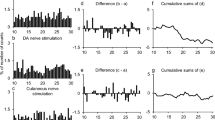Summary
The aim of the present investigation was to study whether the pre-movement inhibition of the H reflex in the antagonist of a ballistic voluntary contraction was due to a reduced activity of the motoneuronal pool of the antagonist, or to a reduced excitatory effect of the afferent volley reaching these motoneurons. Human subjects performed visually conditioned ballistic dorsal flexions of the ankle. The inhibition of the H reflex in the antagonist (soleus muscle) was similar if the muscle was initially relaxed or if there was a preexisting level of motor discharge. Since the soleus muscle was inhibited before movement onset in parallel with the H reflex inhibition, the relation between the level of a background activity and the size of superimposed H reflexes was studied. The finding that H reflexes were only slightly reduced in size with decreasing steady EMG levels could not explain the pre-movement inhibition, and it was concluded than an increased presynaptic inhibition of Ia terminals was the source of the H reflex inhibition.
Similar content being viewed by others
Refrences
Burke D, Gandevia SA, McKeon B (1984) Monosynaptic and oligosynaptic contributions to human ankle jerk and H-reflex. J Neurophysiol 52: 435–448
Coquery JM, Coulmance M (1971) Variations d'amplitude des réflexes avant un mouvement volontaire. Physiol Behav 8: 65–69
Crone C, Hultborn H, Jespersen B, Nielsen J (1987) Reciprocal Ia inhibition between ankle flexors and extensors in man. J Physiol 389: 163–185
Desmedt JE, Godaux E (1977) Ballistic contractions in man: characteristic recruitment pattern of single motor units of the tibialis anterior muscle. J Physiol 264: 673–693
Eichenberger A, Ruegg DG (1983) Facilitation of the H reflex in a simple and choice reaction time situation. Exp Brain Res [Suppl] 7: 130–134
Eichenberger A, Ruegg DG (1984) Relation between the specific H-reflex facilitation preceding a voluntary movement and movement parameters. J Physiol 347: 545–559
Gottlieb GL, Agarwal GC, Stark L (1970) Interactions between the voluntary and postural mechanisms of the human motor system. J Neurophysiol 33: 365–381
Hallett M, Shahani BT, Young RR (1975) EMG analysis of stereotyped voluntary movements in man. J Neurol Neurosurg Psych 38: 1154–1162
Henneman E, Somjen G, Carpenter DO (1965a) Functional significance of cell size in spinal motoneurons. J Neurophysiol 28: 560–580
Henneman E, Somjen G, Carpenter DO (1965b) Excitability and inhibitibility of motoneurons of different sizes. J Neurophysiol 28: 599–620
Hufschmidt HJ, Hufschmidt T (1954) Antagonist inhibition as the earliest sign of a sensorimotor reaction. Nature 174: 607
Hultborn H, Meunier S, Pierrot-Deseilligny E, Shindo M (1987) Changes in presynaptic inhibition of Ia fibres at the onset of voluntary contraction in man. J Physiol 389: 757–772
Kots YM (1969) Supraspinal control of the segmental centres of muscle antagonists in man. I. Reflex excitability of the motor neurones of muscle antagonists in the period of organization of voluntary movements. Biofizika 14: 167–172
Milner-Brown HS, Stein RB, Yemm R (1973) The orderly recruitment of human motor units during voluntary isometric contractions. J Physiol 230: 259–270
Phillips CG (1969) Motor apparatus of the baboon's hand. Proc R Soc B 173: 141–174
Pierrot-Deseilligny E, Lacert P, Cathala HP (1971) Amplitude et variabilité des réflexes monosynaptiques avant un mouvement volontaire. Physiol Beh 7: 495–508
Riedo R, Ruegg DG (1988) Origin of the specific H reflex facilitation preceding a voluntary movement in man. J Physiol 397: 371–388
Simoyama M, Tanaka R (1974) Reciprocal Ia inhibition at the onset of voluntary movements in man. Brain Res 82: 334–337
Wacholder K (1928) Willkürliche Haltung und Bewegung. Erg Physiol 26: 568–775
Watt DGD, Stauffer EK, Taylor A, Reinking RM, Stuart DG (1976) Analysis of muscle receptor connections by spiketriggered averaging. 1. Spindle primary and tendon organ afferents. J Neurophysiol 39: 1375–1392
Author information
Authors and Affiliations
Rights and permissions
About this article
Cite this article
Ruegg, D.G. Ia afferents of the antagonist are inhibited presynaptically before the onset of a ballistic muscle contraction in man. Exp Brain Res 74, 663–666 (1989). https://doi.org/10.1007/BF00247372
Received:
Accepted:
Issue Date:
DOI: https://doi.org/10.1007/BF00247372




